EIA-364-13A插拔力测试方法
#EIA-364-13A电子连接器的插拔力测试方法

电子连接器的插拔力测试方法公告EIA工程标准和出版物是为服务于公众利益而制定的,它是为了消除生产者和购买者之间的误解,促进产品的交流和提高,并帮助购买者在最短时间内挑选到他所需要的满意的产品﹒该标准的提出会促使EIA的成员在生产和销售产品时遵循该标准﹐而它也可以由国内外非EIA成员自愿使用。
对于推荐标准和出版物中采用的文章﹑材料﹑方法﹐EIA在选取时未考虑其专利内容,故在此过程中EIA对任何专利所有者不承担责任﹐对任何采用该标准的机构也不承担责任。
电子工业协会(EIA)工程部出版2001年华盛顿D.C.20006,N.W.Eye大街。
1983年印刷EIA版权所有U.S.A印制测试方法#13A电子连接器的插拔力测试方法此EIA推荐标准是基于国际电子技术委员会(IEC)的技术内容;推荐512—7,测试13a,插拔力,1978.它符合此IEC推荐的所有必要方面.测试方法#13A电子连接器的插拔力测试方法(摘自EIA建议标准NO.1653.在EIA P-5.12工作组组织下提出的。
)注:此TP-13A之前曾作为TP-13发布于EIA推荐标准RS-364-3。
1.0TP—13A插拔力测试2.0目的﹔此测试的目的是介绍一种决定电子连接器或其保护盖所需插拔力的标准方法。
3.0样品准备测试样品由一插头和一可接触端插座组成。
除非特别说明﹐样品应由所有可用硬件包括边缘﹑机罩﹑线夹﹑螺钉﹑导片或插座组成。
除非规格中另有说明,样品不需要任何方法进行润滑或清洗。
4.0测试方法4.1 测试仪器测试仪器包括﹔4.1.1可使样品以正常方式安装的安装夹具。
4.1.2测试中﹐测力表或力距表应置于连接器的合适位置,以便于读数指针位于量规的中间,这样,操作量规可精确到±2%。
4.1.3按要求,附属测量仪器应与测试样品相配合并随带测力表和力矩表(轴压等)。
4.2测试步骤4.2.1除非特别说明﹐样品应按正常情况进行安装。
4.2.2插入力4.2.2.1将两个相配的电子连接器放在机械装配初始位置﹐并且测力表和力矩表的读数为零。
连接器插拔力标准总结

2.连接器插入力≤5.0Kg
D-SUB系列-25P
1.连接器拔出力≥2.5Kg
测试头插拔次数≤20次
插拔速度为25.4mm/分钟
2.连接器插入力≤8.5Kg
D-SUB系列-37P
1.连接器拔出力≥3.0Kg
测试头插拔次数≤5次
插拔速度为12.7mm/分钟
2.连接器插入力≤12.5Kg
1.连接器拔出力≥1.0Kg
测试头插拔次数≤5次
插拔速度为12.7mm/分钟
2.连接器插入力≤5.0Kg
187端子系列
1.连接器拔出力≥1.5Kg
测试头插拔次数≤5次
插拔速度为12.7mm/分钟
2.连接器插入力≤6.5Kg
250端子系列
1.连接器拔出力≥2.0Kg
测试头插拔次数≤6次
插拔速度为12.7mm/分钟
2.连接器插入力≤8.0Kg
IDC端子系列
1.连接器拔出力≥0.06g*Pin数
测试头插拔次数≤10次
插拔速度为12.7mm/分钟
2.连接器插入力≤6.8Kg
测试头插拔次数≤5次
插拔速度为12.7mm/分钟
2.连接器插入力≤3.0Kg
Housing系列-0次
插拔速度为12.7mm/分钟
2.连接器插入力≤3.5Kg
Housing系列-10P
1.连接器拔出力≥0.7Kg
测试头插拔次数≤5次
插拔速度为12.7mm/分钟
USB系列
1.连接器拔出力≥1.0Kg,焊线后注塑成品≥0.8Kg
测试头插拔次数≤10次
插拔速度为12.7mm/分钟
2.连接器插入力≤3.5Kg
Mini-Din系列
连接器插拔力标准
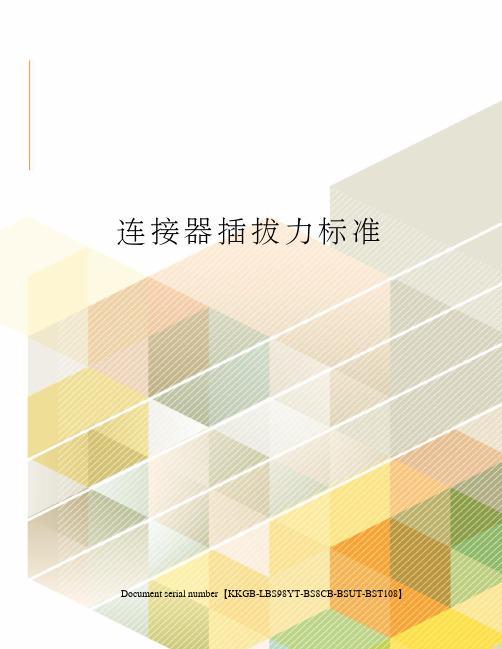
1.连接器拔出力≥1.0Kg
测试头插拔次数≤10次
插拔速度为25.4mm/分钟
2.连接器插入力≤4.5Kg
D-SUB系列-09P
1.连接器拔出力≥1.5Kg
测试头插拔次数≤20次
插拔速度为25.4mm/分钟
2.连接器插入力≤3.5Kg
D-SUB系列-15P
1.连接器拔出力≥2.0Kg
测试头插拔次数≤20次
插拔速度为25.4mm/分钟
2.连接器插入力≤5.0Kg
D-SUB系列-25P
1.连接器拔出力≥2.5Kg
测试头插拔次数≤20次
插拔速度为25.4mm/分钟
2.连接器插入力≤8.5Kg
D-SUB系列-37P
1.连接器拔出力≥3.0Kg
测试头插拔次数≤5次
插拔速度为12.7mm/分钟
2.连接器插入力≤12.5Kg
2.连接器插入力≤3.5Kg
Housing系列-12P
1.连接器拔出力≥1.0Kg
测试头插拔次数≤5次
插拔速度为12.7mm/分钟
2.连接器插入力≤5.0Kg
Housing系列-14P
1.连接器拔出力≥1.0Kg
测试头插拔次数≤5次
插拔速度为12.7mm/分钟
2.连接器插入力≤5.0Kg
Housing系列-16P
测试头插拔次数≤5次
插拔速度为12.7mm/分钟
2.连接器插入力≤3.0Kg
Housing系列-08P
1.连接器拔出力≥0.7Kg
测试头插拔次数≤5次
插拔速度为12.7mm/分钟
2.连接器插入力≤3.5Kg
Housing系列-10P
1.连接器拔出力≥0.7Kg
EIA-364-13A(插拔力)

測試樣品由一插頭和一可接触端插座組成。除非特別說明﹐樣品應由所有可用硬件包括邊緣﹑机罩﹑線夾﹑螺釘﹑導片或插座組成。除非規格中另有說明,樣品不需要任何方法進行潤滑或清洗。
4.0測試方法
4.1 測試儀器
測試儀器包括﹕
4.1.1可使樣品以正常方式安裝的安裝夾具。
4.1.2測試中﹐測力表或力距表應置於連接器的合適位置,以便於讀數指針位於量規的中間,這樣,操作量規可精確到±2%。
4.2.2.3拔出力
按規格中說明的力率將連接器完全拔出﹐並記錄拔出力峰值。
5.0細節說明
按規格要求進行測試時,下列細節將作說明:
(a)被測樣品數目﹔
(b)插入力和拔出力﹔
(c)插拔速率﹔
(d)可能的插入深度。
測試方法#13A
電子連接器的插拔力測試方法
(摘自EIA建議標準NO.1653.在EIA P-5.12工作組組織下提出的。)
注:此TP-13A之前曾作為TP-13發佈於EIA推荐標準RS-364-3。
1.0TP—13A插拔力測試 Nhomakorabea2.0目的﹕
此測試的目的是介紹一种決定電子連接器或其保護蓋所需插拔力的標準方法。
4.1.3按要求,附屬測量儀器應與測試樣品相配合並隨帶測力表和力矩表(軸壓等)。
4.2測試步驟
4.2.1除非特別說明﹐樣品應按正常情況進行安裝。
4.2.2插入力
4.2.2.1將兩個相配的電子連接器放在機械裝配初始位置﹐並且測力表和力矩表的讀數為零。
4.2.2.2按規格中說明的力率將連接器完全充分插入(相配)﹐並記錄插入力峰值。
插拔力测试机操作指导书
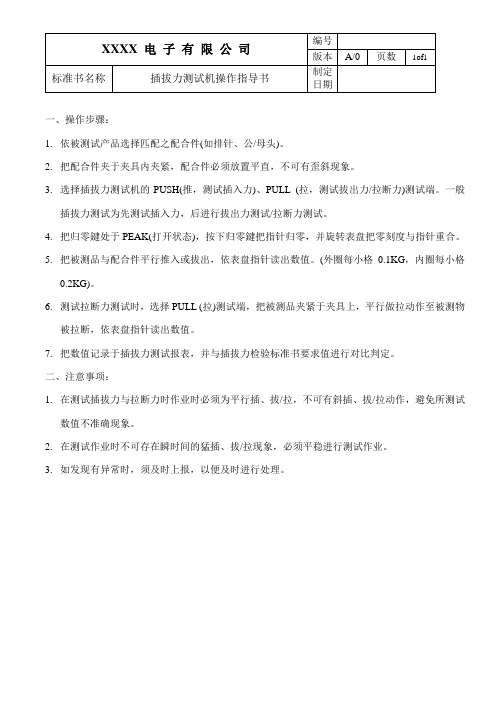
一、操作步骤:
1.依被测试产品选择匹配之配合件(如排针、公/母头)。
2.把配合件夹于夹具内夹紧,配合件必须放置平直,不可有歪斜现象。
3.选择插拔力测试机的PUSH(推,测试插入力)、PULL (拉,测试拔出力/拉断力)测试端。
一般
插拔力测试为先测试插入力,后进行拔出力测试/拉断力测试。
4.把归零鍵处于PEAK(打开状态),按下归零鍵把指针归零,并旋转表盘把零刻度与指针重合。
5.把被测品与配合件平行推入或拔出,依表盘指针读出数值。
(外圈每小格0.1KG,内圈每小格
0.2KG)。
6.测试拉断力测试时,选择PULL (拉)测试端,把被测品夹紧于夹具上,平行做拉动作至被测物
被拉断,依表盘指针读出数值。
7.把数值记录于插拔力测试报表,并与插拔力检验标准书要求值进行对比判定。
二、注意事项:
1.在测试插拔力与拉断力时作业时必须为平行插、拔/拉,不可有斜插、拔/拉动作,避免所测试
数值不准确现象。
2.在测试作业时不可存在瞬时间的猛插、拔/拉现象,必须平稳进行测试作业。
3.如发现有异常时,须及时上报,以便及时进行处理。
插拔力测试

插拔力测试
插拔力测试介绍:
插拔力试验是指将相互配合的公母两端电子连接器进行插入和拔出所需要的力量。
改试验适用于连接器的插入力、拔出力、塑料保持力以及使用寿命等多种测试,透过计算机的分析,可精确测量待测物的荷重、行程及相对应变化曲线,并可准确控制连接器插拔力测试行程、速度、目标测定次数及暂停时间。
插拔力测试标准:
EIA-364-13D-2007
适用产品:
插拔力测试适用产品:
连接器公母头,数据线,耳机等等。
试验设备:
插拔力测试机
测试流程:
1 确认测试条件
2 确认样品数量
3 是否判定(1根据客户要求 2标准判定)
4 测试结果,出具报告
可靠性测试项目:冷热冲击试验,快速温度变化试验,UV紫外光老化试验,氙灯老化及盐雾试验,振动试验,三综合试验等。
EIA-364-13C_插拔力测试标准

EIA STANDARD TP-13C M ATING AND UNMATING FORCE TEST PROCEDURE FOR ELECTRICAL CONNECTORSEIA/ECA-364-13C (Revision of EIA-364-13B) JUNE 2006THE ELECTRONIC COMPONENTS SECTOR OF THE ELECTRONIC INDUSTRIES ALLIANCE ANSI/EIA-364-13C-2006NOTICEEIA Engineering Standards and Publications are designed to serve the public interest through eliminating misunderstandings between manufacturers and purchasers, facilitating interchangeability and improvement of products, and assisting the purchaser in selecting and obtaining with minimum delay the proper product for his particular need. Existence of such Standards and Publications shall not in any respect preclude any member or nonmember of EIA from manufacturing or selling products not conforming to such Standards and Publications, nor shall the existence of such Standards and Publications preclude their voluntary use by those other than EIA members, whether the standard is to be used either domestically or internationally.Standards and Publications are adopted by EIA in accordance with the American National Standards Institute (ANSI) patent policy. By such action, EIA does not assume any liability to any patent owner, nor does it assume any obligation whatever to parties adopting the Standard or Publication.This EIA Standard is considered to have International Standardization implication, but the International Electrotechnical Commission activity has not progressed to the point where a valid comparison between the EIA Standard and the IEC document can be made.This Standard does not purport to address all safety problems associated with its use or all applicable regulatory requirements. It is the responsibility of the user of this Standard to establish appropriate safety and health practices and to determine the applicability of regulatory limitations before its use.(From Standards Proposal No. 5136 formulated under the cognizance of the CE-2.0 National Connector Standards Committee.Published by©ELECTRONIC INDUSTRIES ALLIANCE 2006Technology Strategy & Standards Department2500 Wilson BoulevardArlington, VA 22201PRICE: Please refer to the currentCatalog of EIA Electronic Industries Alliance Standards and EngineeringPublicationsor call Global Engineering Documents, USA and Canada (1-800-854-7179)International (303-397-7956)All rights reservedPrinted in U.S.A.PLEASE !DON'T VIOLATETHELAW!This document is copyrighted by the EIA and may not be reproduced without permission.Organizations may obtain permission to reproduce a limited number of copies through entering into a license agreement. For information, contact:Global Engineering Documents15 Inverness Way EastEnglewood, CO 80112-5704 or callUSA and Canada (1-800-854-7179), International (303-397-7956)CONTENTSClause Page (1)1 Introduction (1)1.1 Scope (1)resources2 Test (1)2.1 Equipment3 Test specimen (1) (1)A3.1 Method (2)3.2 MethodB (2)procedure4 TestA (2)4.1 MethodB (2)4.2 Method5 Details to be specified (3) (3)6 Testdocumentation(This page left blank)TEST PROCEDURE No. 13CMATING AND UNMATING FORCE TEST PROCEDUREFORELECTRICAL CONNECTORS(From EIA Standards Proposal No. 5136, formulated under the cognizance EIA CE-2.0 Committee on National Connector Standards, and previously published in EIA-364-13B.)1 Introduction1.1 ScopeThis standard establishes a method to determine the forces required to mate and unmate electrical connectors or protective caps with connectors, connectors/sockets with gages or devices. Unless otherwise specified in the referencing document, method A shall be used.2 Test resources2.1 EquipmentThe test equipment shall consist of:2.1.1 Mounting fixtures that allow the specimens to be mounted in their normal manner.2.1.2 Force or torque gages, of suitable range for the connector size under test, so that readings will be in the middle 50% of the scale, where practicable, with a nominal full scale accuracy of +2%.2.1.3 Attachments and accessory type equipment as required to mate the test specimens and attach the force or torque gages (arbor press, etc.).2.1.4 Gage(s) or device(s) to mate the connector/socket with (applicable to method B only).3 Test specimen3.1 Method AThe specimen shall consist of a plug and a receptacle with all applicable contacts in place. All applicable hardware shall be assembled to the specimen including skirts, hoods, cable clamps, jackscrews, guide pins or sockets unless otherwise specified. The specimen shall not be lubricated or cleaned in any manner unless otherwise specified in the referencing document. If applicable the specimen shall be terminated as specified in the referencing document.3.2 Method BThe specimen shall consist of the connector/socket and the gage(s) or device(s) as specified in the referencing document. Unless otherwise specified in the referencing document, all applicable contacts and hardware shall be installed including skirts, hoods, cable clamps, guide pins, etc. The specimen shall not be lubricated or cleaned and active latches are to be deactivated unless otherwise specified in the referencing document. If applicable, the specimen shall be terminated as specified in the referencing document.4 Test procedure4.1 Method AUnless otherwise specified, the specimen shall be mounted to mounting fixtures by the normal mounting means.4.1.1 Mating force4.1.1.1 The two mating connectors shall be brought to a position where mechanical mating begins and the force or torque gage is at zero indication.4.1.1.2 The connectors shall then be fully mated or coupled at a rate of 25.4 millimeters/minute, unless otherwise specified in the referencing document, and the peak force or torque required for mating shall be recorded.4.1.2 Unmating forceThe mated connectors shall be fully unmated at a rate of 25.4 millimeters/minute, unless otherwise specified in the referencing document, and the peak force or torque required shall be recorded. 4.2 Method BThe fixtures required to hold the specimen and the specimen shall be attached to the force measuring system then the system shall be zeroed.4.2.1 Mating force4.2.1.1 The two mating components shall be brought to a position just before mechanical mating begins and the force measuring system is indicating zero.4.2.1.2 The gage/device shall then be fully mated to the connector/socket at a rate of 25.4 millimeters/minute, unless otherwise specified in the referencing document. The peak force required for mating prior to bottoming shall be recorded.4.2.2 Unmating forcesThe gage/device shall then be fully unmated from the connector/socket at a rate of 25.4 millimeters/minute unless otherwise specified in the referencing document. The peak force required for unmating shall be recorded.5 Details to be specifiedThe following details shall be specified in the referencing document:5.1 Number of specimens to be tested5.2 Measurements to be made; mating force, unmating force, or both5.3 Rates of mating and unmating, if other than specified in 4.1.1.2, 4.1.2, 4.2.1.2 and 4.2.25.4 Depth of mating if applicable5.5 Lubrication or cleaning, if required5.6 Wire type, gage, and length if applicable5.7 Applicable hardware5.8 Force or torque requirements5.9 Test conditions, if other than standard atmospheric5.10 Applicable to method B only: Details of the device(s) or gage(s) to be used for mating/unmating to the connector/socket, as well as the method and frequency of cleaning, if required6 Test documentationDocumentation shall contain the details specified in clause 5, with any exceptions, and the following:6.1 Title of test6.2Specimen description including part number if applicable6.3 If applicable, fixturing, gage details and gage part number6.4 Test equipment used, and date of last and next calibration6.5 Test procedure and method, if other than method A6.6 Values and observation6.7 Name of operator and date of testEIA Document Improvement ProposalIf in the review or use of this document, a potential change is made evident for safety, health or technical reasons, please fill in the appropriate information below and mail or FAX to:Electronic Industries AllianceTechnology Strategy & Standards Department – Publications Office2500 Wilson Blvd.Arlington, VA 22201FAX: (703-875-8906)Revision HistoryRevision letter Projectnumber Additions, changes and deletionsC SP-5136Original test procedure is now method A.Added Method B and paragraph 2.1.4, 3.2, 4.2, 5.10and 6.3.Revised paragraph 1.1, 4.1.1.2, 4.1.2, 5.2, 5.3, 6.2and 6.5.。
连接器插拔力标准
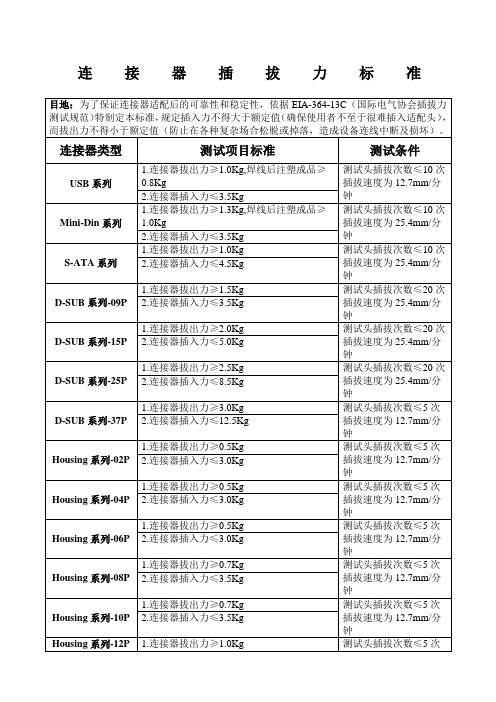
IDC端子系列
1.连接器拔出力≥0.06g*Pin数
测试头插拔次数≤10次
插拔速度为12.7mm/分钟
2.连接器插入力≤6.8Kg
1.连接器拔出力≥1.0Kg
测试头插拔次数≤10次
插拔速度为25.4mm/分钟
2.连接器插入力≤4.5Kg
D-SUB系列-09P
1.连接器拔出力≥1.5Kg
测试头插拔次数≤20次
插拔速度为25.4mm/分钟
2.连接器插入力≤3.5Kg
D-SUB系列-15P
1.连接器拔出力≥2.0Kg
测试头插拔次数≤20次
USB系列
1.连接器拔出力≥1.0Kg,焊线后注塑成品≥0.8Kg
测试头插拔次数≤10次
插拔速度为12.7mm/分钟
2.连接器插入力≤3.5Kg
Mini-Din系列
1.连接器拔出力≥1.3Kg,焊线后注塑成品≥1.0Kg
测试头插拔次数≤10次
插拔速度为25.4mm/分钟
2.连接器插入力≤3.5Kg
S-ATA系列
Housing系列-02P
1.连接器拔出力≥0.5Kg
测试头插拔次数≤5次
插拔速度为12.7mm/分钟
2.连接器插入力≤3.0Kg
Housing系列-04P
1.连接器拔出力≥0.5Kg
测试头插拔次数≤5次
插拔速度为12.7mm/分钟
2.连接器插入力≤3.0Kg
Housing系列-06P
1.连接器拔出力≥0.5Kg
2.连接器插入力≤3.5Kg
Housing系列-12P
1.连接器拔出力≥1.0Kg
测试头插拔次数≤5次
插拔速度为12.7mm/分钟
连接器可靠性测试项目介绍

连接器可靠性测试项目介绍连接器是将一个回路上的两个导体桥接起来,使得电流或者讯号可以从一个导体流向另一个导体的导体设备。
连接器形式和结构是千变万化的,随着应用对象、频率、功率、应用环境等不同,有各种不同形式的连接器。
连接器做可靠性测试项目有插拔力测试、耐久性测试、绝缘电阻测试、振动测试、机械冲击测试、冷热冲击测试、混合气体腐蚀测试等。
连接器可靠性测试方法:1、插拔力测试参考标准:EIA-364-13目的:验证连接器的插拔力是否符合产品规格要求;原理:将连接器按规定速率进行完全插合或拔出,记录相应的力值。
2、耐久性测试参考标准:EIA-364-09目的:评估反复插拔对连接器的影响,模拟实际使用中连接器的插拔状况。
原理:按照规定速率连续插拔连接器直至达到规定次数。
3、绝缘电阻测试参考标准:EIA-364-21目的:验证连接器的绝缘性能是否符合电路设计的要求或经受高温,潮湿等环境应力时,其阻值是否符合有关技术条件的规定。
原理:在连接器的绝缘部分施加电压,从而使绝缘部分的表面或内部产生漏电流而呈现出来的电阻值。
4、耐电压测试参考标准:EIA-364-20目的:验证连接器在额定电压下是否能安全工作,能否耐受过电位的能力,从而评定连接器绝缘材料或绝缘间隙是否合适原理:在连接器接触件与接触件之间,接触件与外壳之间施加规定电压并保持规定时间,观察样品是否有击穿或放电现象。
5、接触电阻测试参考标准:EIA-364-06/EIA-364-23目的:验证电流流经接触件的接触表面时产生的电阻值原理:通过对连接器通规定电流,测量连接器两端电压降从而得出电阻值6、振动测试:参考标准:EIA-364-28目的:验证振动对电连接器及其组件性能的影响。
振动类型:随机振动,正弦振动7、机械冲击测试参考标准:EIA-364-27目的:验证连接器及其组件耐冲击的能力或评定其结构是否牢固;测试波形:半正弦波,方波。
8、冷热冲击测试参考标准:EIA-364-32目的:评估连接器在急速的大温差变化下,对于其功能品质的影响。
插拔力试验机的详细操作步骤
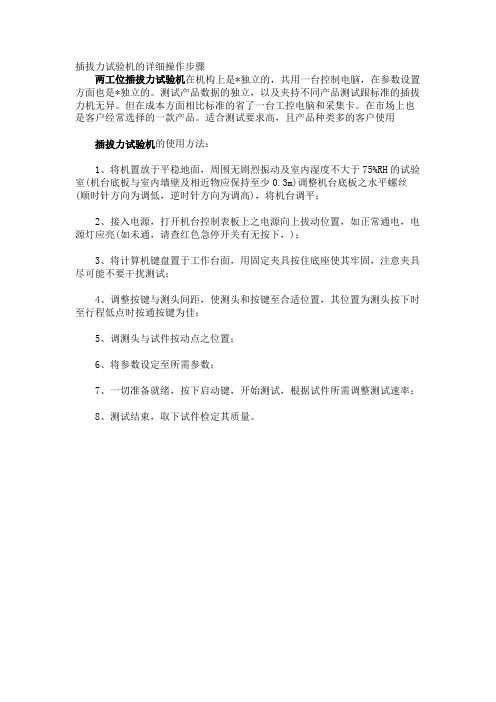
插拔力试验机的详细操作步骤
两工位插拔力试验机在机构上是*独立的,共用一台控制电脑,在参数设置方面也是*独立的。
测试产品数据的独立,以及夹持不同产品测试跟标准的插拔力机无异。
但在成本方面相比标准的省了一台工控电脑和采集卡。
在市场上也是客户经常选择的一款产品。
适合测试要求高,且产品种类多的客户使用
插拔力试验机的使用方法:
1、将机置放于平稳地面,周围无剧烈振动及室内湿度不大于75%RH的试验室(机台底板与室内墙壁及相近物应保持至少0.3m)调整机台底板之水平螺丝(顺时针方向为调低,逆时针方向为调高),将机台调平;
2、接入电源,打开机台控制表板上之电源向上拔动位置,如正常通电,电源灯应亮(如未通,请查红色急停开关有无按下,);
3、将计算机键盘置于工作台面,用固定夹具按住底座使其牢固,注意夹具尽可能不要干扰测试;
4、调整按键与测头间距,使测头和按键至合适位置,其位置为测头按下时至行程低点时按通按键为佳;
5、调测头与试件按动点之位置;
6、将参数设定至所需参数;
7、一切准备就绪,按下启动键,开始测试,根据试件所需调整测试速率;
8、测试结束,取下试件检定其质量。
常规工程连接器Q test测试说明
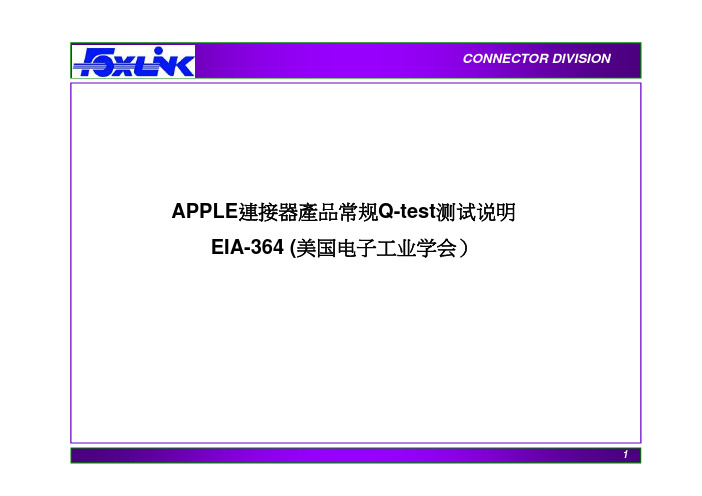
CONNECTOR DIVISIONAPPLE連接器產品常规Q-test测试说明EIA-364 (美国电子工业学会)EIA-364(CONNECTOR DIVISION1. Low Level Contact Resistance (LLCR) 低阶接触阻抗2. Insulation Resistance 绝缘阻抗3. Dielectric Withstanding Voltage 耐电压4Temperature rise电气性能 4. Temperature rise温升5. 其它电气特性:电磁干扰泄露衰减;特性阻抗;插入损耗;反射系数,电压驻波比;串扰,传输延迟;时滞。
1. Mating/ unmating Force 插拔力2. Durability 寿命测试3. Contact retention force 端子保持力4. Contact normal force常规三机械性能端子正向力5. Vibration振动测试6.Physical shock振动冲击测试大测试1. Heat Soak 热储存测试2. Thermal Cycling 热循环测试3. Thermal Shock 冷热冲击测试环境性能冷热冲击测4. Humidity Cycling 温湿度组合循环测试5. Temperature Life 高温测试6.Salt Spray 盐雾测试7. Resistance to Soldering Heat 耐焊接热CONNECTOR DIVISION1.Low Level Contact Resistance (LLCR) 低阶接触阻抗测试1定义:1.任何金屬表面可能有a.灰塵b.氧化物c.油污等雜質, 當兩金屬表面接觸後該介質會影響電流之流通, 一般稱之為接觸阻抗. 高品质的连接器应当具有低而稳定的接触阻抗,连接器的接触阻抗从几毫欧到数十毫欧不等。
2.目的:在不破坏端子表面的氧化膜的情况下,测试结合的两个端子之间的接触阻值,以作为连接器端子的总体性评估.3. 方法:a)以四线量测法量测结合端子之电阻值b)测试电流:100mA max b)测试电流100mA max c)测试电压:DC 20mV max备注:常规CR测试电流和电压: DC 5V ;1A .4.参考标准:EIA-364-235测试仪器微欧姆机5.测试仪器:微欧姆机(设备自身就应具备四线法测试功能,它应有四个外接插孔。
连接器插拔力标准
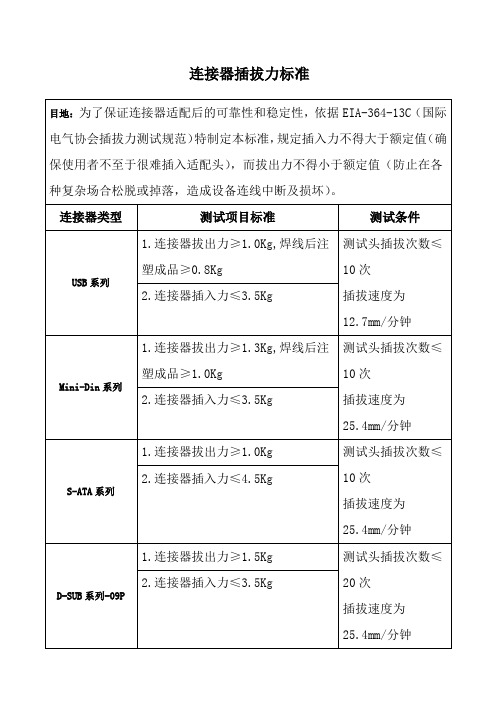
插拔速度为12.7mm/分钟
2.连接器插入力≤3.0Kg
Housing系列-08P
1.连接器拔出力≥0.7Kg
测试头插拔次数≤5次
插拔速度为12.7mm/分钟
2.连接器插入力≤3.5Kg
Housing系列-10P
1.连接器拔出力≥0.7Kg
测试头插拔次数≤5次
插拔速度为12.7mm/分钟
连接器插拔力标准
目地:为了保证连接器适配后的可靠性和稳定性,依据EIA-364-13C(国际电气协会插拔力测试规范)特制定本标准,规定插入力不得大于额定值(确保使用者不至于很难插入适配头),而拔出力不得小于额定值(防止在各种复杂场合松脱或掉落,造成设备连线中断及损坏)。
连接器类型
测试项目标准
测试条件
插拔速度为25.4mm/分钟
2.连接器插入力≤5.0Kg
D-SUB系列-25P
1.连接器拔出力≥2.5Kg
测试头插拔次数≤20次
插拔速度为25.4mm/分钟
2.连接器插入力≤8.5Kg
D-SUB系列-37P
1.连接器拔出力≥3.0Kg
测试头插拔次数≤5次
插拔速度为12.7mm/分钟
2.连接器插入力≤12.5Kg
1.连接器拔出力≥1.0Kg
测试头插拔次≤5次
插拔速度为12.7mm/分钟
2.连接器插入力≤5.0Kg
187端子系列
1.连接器拔出力≥1.5Kg
测试头插拔次数≤5次
插拔速度为12.7mm/分钟
2.连接器插入力≤6.5Kg
250端子系列
1.连接器拔出力≥2.0Kg
测试头插拔次数≤6次
插拔速度为12.7mm/分钟
2.连接器插入力≤8.0Kg
连接器插拔力标准
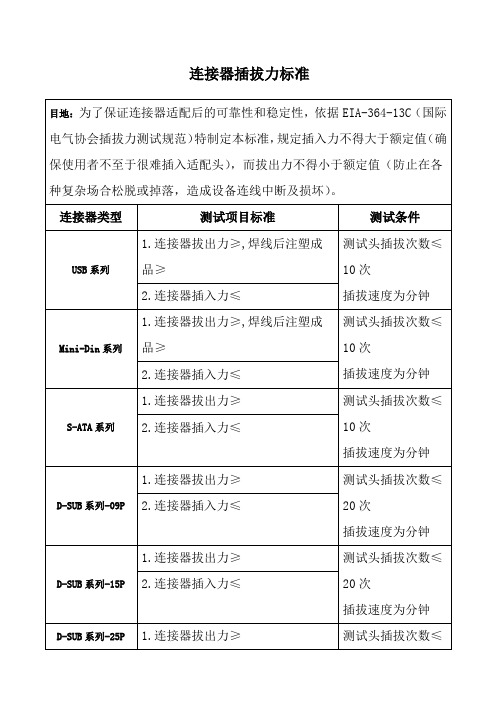
Housing系列-14P
1.连接器拔出力≥
测试头插拔次数≤5次
插拔速度为分钟
2.连接器插入力≤
Housing系列-16P
1.连接器拔出力≥
测试头插拔次数≤5次
插拔速度为分钟
2.连接器插入力≤
187端子系列
1.连接器拔出力≥
测试头插拔次数≤5次
插拔速度为分钟
2.连接器插入力≤
250端子系列
测试头插拔次数≤5次
插拔速度为分钟
2.连接器插入力≤
Housing系列-02P
1.连接器拔出力≥
测试头插拔次数≤5次
插拔速度为分钟
2.连接器插入力≤
Housing系列-04P
1.连接器拔出力≥
测试头插拔次数≤5次
插拔速度为分钟
2.连接器插入力≤
Housing系列-06P
1.连接器拔出力≥
测试头插拔次数≤5次
1.连接器拔出力≥
测试头插拔次数≤6次
插拔速度为分钟
2.连接器插入力≤
IDC端子系列
1.连接器拔出力≥*Pin数
测试头插拔次数≤10次
插拔速度为分钟
2.连接器插入力≤
USB系列
1.连接器拔出力≥,焊线后注塑成品≥
测试头插拔次数≤10次
插拔速度为分钟
2.连接器插入力≤
Mini-Din系列
1.连接器拔出力≥,焊线后注塑成品≥
测试头插拔次数≤10次
插拔速度为分钟
2.连接器插入力≤
S-ATA系列
1.连接器拔出力≥
测试头插拔次数≤10次
插拔速度为分钟
2.连接器插入力≤
D-SUB系列-09P
连接器插拔力标准
#EIA-364-35A电子连接器插入保持力测试方法
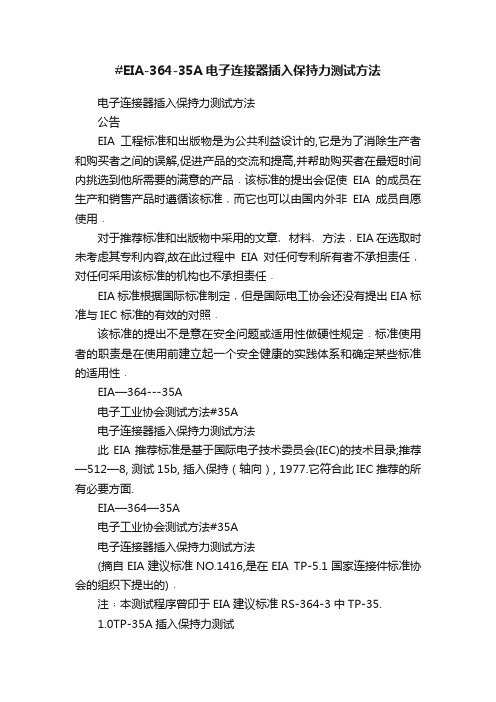
#EIA-364-35A电子连接器插入保持力测试方法电子连接器插入保持力测试方法公告EIA工程标准和出版物是为公共利益设计的,它是为了消除生产者和购买者之间的误解,促进产品的交流和提高,并帮助购买者在最短时间内挑选到他所需要的满意的产品﹒该标准的提出会促使EIA的成员在生产和销售产品时遵循该标准﹐而它也可以由国内外非EIA成员自愿使用﹒对于推荐标准和出版物中采用的文章﹑材料﹑方法﹐EIA在选取时未考虑其专利内容,故在此过程中EIA对任何专利所有者不承担责任﹐对任何采用该标准的机构也不承担责任﹒EIA标准根据国际标准制定﹐但是国际电工协会还没有提出EIA标准与IEC 标准的有效的对照﹒该标准的提出不是意在安全问题或适用性做硬性规定﹒标准使用者的职责是在使用前建立起一个安全健康的实践体系和确定某些标准的适用性﹒EIA—364---35A电子工业协会测试方法#35A电子连接器插入保持力测试方法此EIA推荐标准是基于国际电子技术委员会(IEC)的技术目录;推荐—512—8, 测试15b, 插入保持(轴向), 1977.它符合此IEC推荐的所有必要方面.EIA—364—35A电子工业协会测试方法#35A电子连接器插入保持力测试方法(摘自EIA建议标准NO.1416,是在EIA TP-5.1国家连接件标准协会的组织下提出的)﹒注﹔本测试程序曾印于EIA建议标准RS-364-3中TP-35.1.0TP-35A插入保持力测试2.0 目的本方法是说明一种估计电子连接器在使用期间插入保持系统承受轴向机械应力的标准方法﹒3.0样品准备测试样品应由一个插头或插座﹐去掉所有相关部件﹐是否使用导线见说明﹒4.0 测试方法4.1 测试仪器4.1.1适当的夹持装置﹒4.1.2满偏量程精度在±2%的测力表﹒4.2 测试步骤测试样品应如详细说明中那样受到两个方向的轴向加载﹒加载速率约为10psi/sec并持续1分钟﹒再有加载应作用于最大的实际插入面积﹒注意﹔在有空气压力的地方﹐插入端或接触端﹐或两者均会受到高速排斥的危险﹗5.0 最终测量当完成以上测试后﹐应目视检查样品插入位置从初始位置进行转6.0细节说明以下细节将在细节说明中说明﹔(a) 测试样品的准备?(b) 样品的安装?(c) 应用力﹒7.0 参考文件(a) 测试题目?(b) 样品描述包括夹具?(c) 所使用的仪器?(d) 测试步骤?(e) 评估和观测?(f) 测试日期和操作者姓名﹒。
插拔力试验方法

插拔力试验方法插拔力试验方法是一种用于测试插接件或连接器的插拔性能的实验方法。
这种方法主要通过模拟实际使用情况,对插接件或连接器进行多次插拔操作,以评估其插拔性能的可靠性和耐久性。
一、试验原理和目的插拔力试验方法的基本原理是通过施加一定的插拔力和频率,对插接件或连接器进行插拔操作,观察其在不同插拔次数下的插拔力变化。
通过此试验可以评估插接件或连接器的插拔性能,以确定其在实际使用中的可靠性和耐久性。
插拔力试验的主要目的包括:1. 评估插接件或连接器的插拔性能,判断其是否能满足设计要求;2. 比较不同插接件或连接器的插拔性能,选择性能更好的产品;3. 检测插接件或连接器在长时间使用后的插拔力变化情况,评估其使用寿命。
二、试验步骤和方法1. 准备工作:选择适当的插拔力试验设备和夹具,根据试验要求调整设备参数。
对插接件或连接器进行外观检查,确保其无损坏或污染。
2. 安装插接件或连接器:按照产品说明书或标准要求,正确安装插接件或连接器到试验设备上,保证插头和插座之间的对位准确。
3. 设定试验参数:根据试验要求,设定插拔力的大小、频率和插拔次数等参数。
4. 进行试验:开始进行插拔力试验,按照设定的参数进行插拔操作,记录每次插拔的插拔力值。
5. 数据分析:根据试验结果,进行数据分析和处理,计算平均插拔力值、最大插拔力值、插拔力的变化趋势等。
6. 结果评估:根据试验结果和产品要求,评估插接件或连接器的插拔性能是否满足要求,给出相应的评价和建议。
三、试验注意事项1. 遵循试验标准:根据产品的要求和相关标准,选择适当的插拔力试验标准进行试验。
2. 控制试验环境:试验应在干燥、无尘、无振动的环境中进行,避免外界因素对试验结果的影响。
3. 注意安全问题:在试验过程中,要注意保护试验人员的安全,避免因操作不当而导致意外事故的发生。
4. 观察插拔力变化:试验过程中要及时观察插拔力的变化情况,记录每次插拔的插拔力值,确保数据的准确性。
连接器插拔力标准
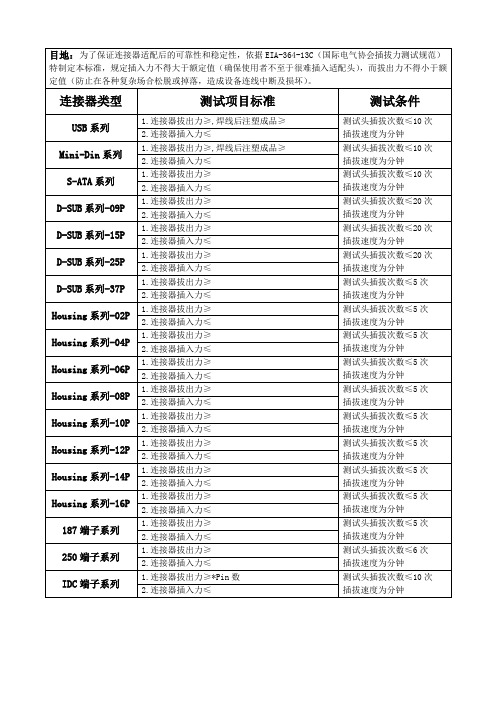
连接器类型
测试项目标准
测试条件
USB系列
1.连接器拔出力≥,焊线后注塑成品≥
1.连接器拔出力≥
测试头插拔次数≤5次
插拔速度为分钟
2.连接器插入力≤
Housing系列-10P
1.连接器拔出力≥
测试头插拔次数≤5次
插拔速度为分钟
2.连接器插入力≤
Housing系列-12P
1.连接器拔出力≥
测试头插拔次数≤5次
插拔速度为分钟
2.连接器插入力≤
Housing系列-14P
1.连接器拔出力≥
测试头插拔次数≤10次
插拔速度为分钟
2.连接器插入力≤
Mini-Din系列
1.连接器拔出力≥,焊线后注塑成品≥
测试头插ห้องสมุดไป่ตู้次数≤10次
插拔速度为分钟
2.连接器插入力≤
S-ATA系列
1.连接器拔出力≥
测试头插拔次数≤10次
插拔速度为分钟
2.连接器插入力≤
D-SUB系列-09P
1.连接器拔出力≥
测试头插拔次数≤20次
插拔速度为分钟
2.连接器插入力≤
D-SUB系列-15P
1.连接器拔出力≥
测试头插拔次数≤20次
插拔速度为分钟
2.连接器插入力≤
D-SUB系列-25P
1.连接器拔出力≥
测试头插拔次数≤20次
插拔速度为分钟
#EIA-364-35A电子连接器插入保持力测试方法
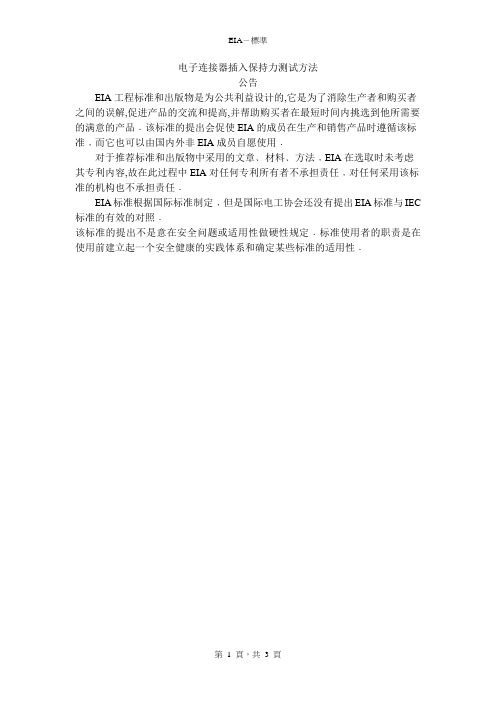
电子连接器插入保持力测试方法公告EIA工程标准和出版物是为公共利益设计的,它是为了消除生产者和购买者之间的误解,促进产品的交流和提高,并帮助购买者在最短时间内挑选到他所需要的满意的产品﹒该标准的提出会促使EIA的成员在生产和销售产品时遵循该标准﹐而它也可以由国内外非EIA成员自愿使用﹒对于推荐标准和出版物中采用的文章﹑材料﹑方法﹐EIA在选取时未考虑其专利内容,故在此过程中EIA对任何专利所有者不承担责任﹐对任何采用该标准的机构也不承担责任﹒EIA标准根据国际标准制定﹐但是国际电工协会还没有提出EIA标准与IEC 标准的有效的对照﹒该标准的提出不是意在安全问题或适用性做硬性规定﹒标准使用者的职责是在使用前建立起一个安全健康的实践体系和确定某些标准的适用性﹒EIA—364---35A电子工业协会测试方法#35A电子连接器插入保持力测试方法此EIA推荐标准是基于国际电子技术委员会(IEC)的技术目录;推荐—512—8, 测试15b, 插入保持(轴向), 1977.它符合此IEC推荐的所有必要方面.EIA—364—35A电子工业协会测试方法#35A电子连接器插入保持力测试方法(摘自EIA建议标准NO.1416,是在EIA TP-5.1国家连接件标准协会的组织下提出的)﹒注﹔本测试程序曾印于EIA建议标准RS-364-3中TP-35.1.0TP-35A插入保持力测试2.0 目的本方法是说明一种估计电子连接器在使用期间插入保持系统承受轴向机械应力的标准方法﹒3.0样品准备测试样品应由一个插头或插座﹐去掉所有相关部件﹐是否使用导线见说明﹒4.0 测试方法4.1 测试仪器4.1.1适当的夹持装置﹒4.1.2满偏量程精度在±2%的测力表﹒4.2 测试步骤测试样品应如详细说明中那样受到两个方向的轴向加载﹒加载速率约为10psi/sec并持续1分钟﹒再有加载应作用于最大的实际插入面积﹒注意﹔在有空气压力的地方﹐插入端或接触端﹐或两者均会受到高速排斥的危险﹗5.0 最终测量当完成以上测试后﹐应目视检查样品插入位置从初始位置进行转6.0细节说明以下细节将在细节说明中说明﹔(a) 测试样品的准备(b) 样品的安装(c) 应用力﹒7.0 参考文件(a) 测试题目(b) 样品描述包括夹具(c) 所使用的仪器(d) 测试步骤(e) 评估和观测(f) 测试日期和操作者姓名﹒。
EIA-364-13C_插拔力测试标准

EIA STANDARD TP-13C M ATING AND UNMATING FORCE TEST PROCEDURE FOR ELECTRICAL CONNECTORSEIA/ECA-364-13C (Revision of EIA-364-13B) JUNE 2006THE ELECTRONIC COMPONENTS SECTOR OF THE ELECTRONIC INDUSTRIES ALLIANCE ANSI/EIA-364-13C-2006NOTICEEIA Engineering Standards and Publications are designed to serve the public interest through eliminating misunderstandings between manufacturers and purchasers, facilitating interchangeability and improvement of products, and assisting the purchaser in selecting and obtaining with minimum delay the proper product for his particular need. Existence of such Standards and Publications shall not in any respect preclude any member or nonmember of EIA from manufacturing or selling products not conforming to such Standards and Publications, nor shall the existence of such Standards and Publications preclude their voluntary use by those other than EIA members, whether the standard is to be used either domestically or internationally.Standards and Publications are adopted by EIA in accordance with the American National Standards Institute (ANSI) patent policy. By such action, EIA does not assume any liability to any patent owner, nor does it assume any obligation whatever to parties adopting the Standard or Publication.This EIA Standard is considered to have International Standardization implication, but the International Electrotechnical Commission activity has not progressed to the point where a valid comparison between the EIA Standard and the IEC document can be made.This Standard does not purport to address all safety problems associated with its use or all applicable regulatory requirements. It is the responsibility of the user of this Standard to establish appropriate safety and health practices and to determine the applicability of regulatory limitations before its use.(From Standards Proposal No. 5136 formulated under the cognizance of the CE-2.0 National Connector Standards Committee.Published by©ELECTRONIC INDUSTRIES ALLIANCE 2006Technology Strategy & Standards Department2500 Wilson BoulevardArlington, VA 22201PRICE: Please refer to the currentCatalog of EIA Electronic Industries Alliance Standards and EngineeringPublicationsor call Global Engineering Documents, USA and Canada (1-800-854-7179)International (303-397-7956)All rights reservedPrinted in U.S.A.PLEASE !DON'T VIOLATETHELAW!This document is copyrighted by the EIA and may not be reproduced without permission.Organizations may obtain permission to reproduce a limited number of copies through entering into a license agreement. For information, contact:Global Engineering Documents15 Inverness Way EastEnglewood, CO 80112-5704 or callUSA and Canada (1-800-854-7179), International (303-397-7956)CONTENTSClause Page (1)1 Introduction (1)1.1 Scope (1)resources2 Test (1)2.1 Equipment3 Test specimen (1) (1)A3.1 Method (2)3.2 MethodB (2)procedure4 TestA (2)4.1 MethodB (2)4.2 Method5 Details to be specified (3) (3)6 Testdocumentation(This page left blank)TEST PROCEDURE No. 13CMATING AND UNMATING FORCE TEST PROCEDUREFORELECTRICAL CONNECTORS(From EIA Standards Proposal No. 5136, formulated under the cognizance EIA CE-2.0 Committee on National Connector Standards, and previously published in EIA-364-13B.)1 Introduction1.1 ScopeThis standard establishes a method to determine the forces required to mate and unmate electrical connectors or protective caps with connectors, connectors/sockets with gages or devices. Unless otherwise specified in the referencing document, method A shall be used.2 Test resources2.1 EquipmentThe test equipment shall consist of:2.1.1 Mounting fixtures that allow the specimens to be mounted in their normal manner.2.1.2 Force or torque gages, of suitable range for the connector size under test, so that readings will be in the middle 50% of the scale, where practicable, with a nominal full scale accuracy of +2%.2.1.3 Attachments and accessory type equipment as required to mate the test specimens and attach the force or torque gages (arbor press, etc.).2.1.4 Gage(s) or device(s) to mate the connector/socket with (applicable to method B only).3 Test specimen3.1 Method AThe specimen shall consist of a plug and a receptacle with all applicable contacts in place. All applicable hardware shall be assembled to the specimen including skirts, hoods, cable clamps, jackscrews, guide pins or sockets unless otherwise specified. The specimen shall not be lubricated or cleaned in any manner unless otherwise specified in the referencing document. If applicable the specimen shall be terminated as specified in the referencing document.3.2 Method BThe specimen shall consist of the connector/socket and the gage(s) or device(s) as specified in the referencing document. Unless otherwise specified in the referencing document, all applicable contacts and hardware shall be installed including skirts, hoods, cable clamps, guide pins, etc. The specimen shall not be lubricated or cleaned and active latches are to be deactivated unless otherwise specified in the referencing document. If applicable, the specimen shall be terminated as specified in the referencing document.4 Test procedure4.1 Method AUnless otherwise specified, the specimen shall be mounted to mounting fixtures by the normal mounting means.4.1.1 Mating force4.1.1.1 The two mating connectors shall be brought to a position where mechanical mating begins and the force or torque gage is at zero indication.4.1.1.2 The connectors shall then be fully mated or coupled at a rate of 25.4 millimeters/minute, unless otherwise specified in the referencing document, and the peak force or torque required for mating shall be recorded.4.1.2 Unmating forceThe mated connectors shall be fully unmated at a rate of 25.4 millimeters/minute, unless otherwise specified in the referencing document, and the peak force or torque required shall be recorded. 4.2 Method BThe fixtures required to hold the specimen and the specimen shall be attached to the force measuring system then the system shall be zeroed.4.2.1 Mating force4.2.1.1 The two mating components shall be brought to a position just before mechanical mating begins and the force measuring system is indicating zero.4.2.1.2 The gage/device shall then be fully mated to the connector/socket at a rate of 25.4 millimeters/minute, unless otherwise specified in the referencing document. The peak force required for mating prior to bottoming shall be recorded.4.2.2 Unmating forcesThe gage/device shall then be fully unmated from the connector/socket at a rate of 25.4 millimeters/minute unless otherwise specified in the referencing document. The peak force required for unmating shall be recorded.5 Details to be specifiedThe following details shall be specified in the referencing document:5.1 Number of specimens to be tested5.2 Measurements to be made; mating force, unmating force, or both5.3 Rates of mating and unmating, if other than specified in 4.1.1.2, 4.1.2, 4.2.1.2 and 4.2.25.4 Depth of mating if applicable5.5 Lubrication or cleaning, if required5.6 Wire type, gage, and length if applicable5.7 Applicable hardware5.8 Force or torque requirements5.9 Test conditions, if other than standard atmospheric5.10 Applicable to method B only: Details of the device(s) or gage(s) to be used for mating/unmating to the connector/socket, as well as the method and frequency of cleaning, if required6 Test documentationDocumentation shall contain the details specified in clause 5, with any exceptions, and the following:6.1 Title of test6.2Specimen description including part number if applicable6.3 If applicable, fixturing, gage details and gage part number6.4 Test equipment used, and date of last and next calibration6.5 Test procedure and method, if other than method A6.6 Values and observation6.7 Name of operator and date of testEIA Document Improvement ProposalIf in the review or use of this document, a potential change is made evident for safety, health or technical reasons, please fill in the appropriate information below and mail or FAX to:Electronic Industries AllianceTechnology Strategy & Standards Department – Publications Office2500 Wilson Blvd.Arlington, VA 22201FAX: (703-875-8906)Revision HistoryRevision letter Projectnumber Additions, changes and deletionsC SP-5136Original test procedure is now method A.Added Method B and paragraph 2.1.4, 3.2, 4.2, 5.10and 6.3.Revised paragraph 1.1, 4.1.1.2, 4.1.2, 5.2, 5.3, 6.2and 6.5.。
连接器插拔力标准
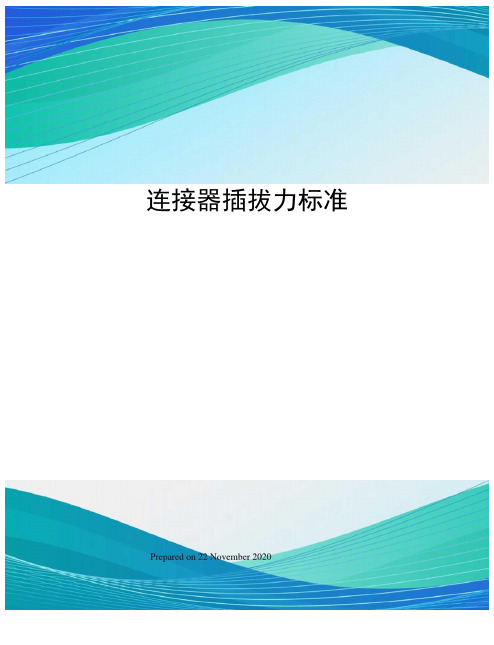
测试头插拔次数W5次 插拔速度为分钟
2.连接器插入力W
D-SUB系列・37P
1.连接器拔出力N
测试头插拔次数W5次 插拔速度为分钟
2.连接器插入力W
Housing系列・02P
1.连接器拔出力N
测试头插拔次数W5using系列・04P
1.连接器拔出力N
测试头插拔次数W5次 插拉速度为分钟
2.连接器插入力W
Housing系列・06P
2.连接器插入力W
D-SUB系列09P
1.连接器拔出力N
测试头插拔次数w20次 插拉速度为分钟
2.连接器插入力W
D-SUB系列・15P
1.连接器拔出力N
测试头插拔次数W20次 插拉速度为分钟
2.连接器插入力W
D-SUB系列・25P
1.连接器拔出力N
测试头插拔次数W20次 插拔速度为分钟
2.连接器插入力W
测试项目标准
测试条件
USB系列
1.连接器拔出力N,焊线后注塑成品N
测试头插拔次数W1。次 插拉速度为分钟
2.连接器插入力W
Mini-Din系列
1.连接器拔出力N,焊线后注塑成品N
测试头插拔次数W1。次 插拉速度为分钟
2.连接器插入力W
S-ATA系列
1.连接器拔出力N
测试头插拔次数W10次 插拉速度为分钟
连接器插拔力标准
连接器插拔力标准
目地:为了保证连接器适配后的可靠性和稳定性,依据EIA-364-13C(国际电气协会插拔力 测试规范)特制定本标准,规定插入力不得大于额定值(确保使用者不至于很难插入适配 头),而拔出力不得小于额定值(防止在各种复杂场合松脱或掉落,造成设备连线中断及 损坏)。
连接器类型
- 1、下载文档前请自行甄别文档内容的完整性,平台不提供额外的编辑、内容补充、找答案等附加服务。
- 2、"仅部分预览"的文档,不可在线预览部分如存在完整性等问题,可反馈申请退款(可完整预览的文档不适用该条件!)。
- 3、如文档侵犯您的权益,请联系客服反馈,我们会尽快为您处理(人工客服工作时间:9:00-18:30)。
電子連接器的插拔力測試方法
公告
EIA工程標准和出版物是為服務於公眾利益而制定的,它是為了消除生產者和購買者之間的誤解,促進產品的交流和提高,並幫助購買者在最短時間內挑選到他所需要的滿意的產品﹒該標準的提出會促使EIA的成員在生產和銷售產品時遵循該標準﹐而它也可以由國內外非EIA成員自愿使用。
對于推荐標准和出版物中采用的文章﹑材料﹑方法﹐EIA在選取時未考慮其專利內容,故在此過程中EIA對任何專利所有者不承擔責任﹐對任何采用該標準的機構也不承擔責任。
電子工業協會(EIA)工程部出版
2001年華盛頓D.C.20006,N.W. Eye大街。
1983年印刷
EIA版權所有
U.S.A印制
測試方法#13A
電子連接器的插拔力測試方法
此EIA推荐標准是基于國際電子技術委員會(IEC)的技術內容;推荐512—7, 測試13a,插拔力,1978.它符合此IEC推荐的所有必要方面.
測試方法#13A
電子連接器的插拔力測試方法
(摘自EIA建議標準NO.1653.在EIA P-5.12工作組組織下提出的。
)
注:此TP-13A之前曾作為TP-13發佈於EIA推荐標準RS-364-3。
1.0TP—13A插拔力測試
2.0目的﹔
此測試的目的是介紹一种決定電子連接器或其保護蓋所需插拔力的標準方法。
3.0樣品准備
測試樣品由一插頭和一可接触端插座組成。
除非特別說明﹐樣品應由所有可用硬件包括邊緣﹑机罩﹑線夾﹑螺釘﹑導片或插座組成。
除非規格中另有說明,樣品不需要任何方法進行潤滑或清洗。
4.0測試方法
4.1 測試儀器
測試儀器包括﹔
4.1.1可使樣品以正常方式安裝的安裝夾具。
4.1.2測試中﹐測力表或力距表應置於連接器的合適位置,以便於讀數
指針位於量規的中間,這樣,操作量規可精確到±2%。
4.1.3按要求,附屬測量儀器應與測試樣品相配合並隨帶測力表和力矩
表(軸壓等)。
4.2測試步驟
4.2.1除非特別說明﹐樣品應按正常情況進行安裝。
4.2.2插入力
4.2.2.1將兩個相配的電子連接器放在機械裝配初始位置﹐並且測
力表和力矩表的讀數為零。
4.2.2.2按規格中說明的力率將連接器完全充分插入(相配)﹐並記
錄插入力峰值。
4.2.2.3拔出力
按規格中說明的力率將連接器完全拔出﹐並記錄拔出力峰值。
5.0細節說明
按規格要求進行測試時,下列細節將作說明:
(a)被測樣品數目
(b)插入力和拔出力
(c)插拔速率
(d)可能的插入深度。
6.0 參考文件
數據表單包括:
(a)測試標題
(b)樣品描述包括安裝工具(c)所用的測試儀器
(d)測試步驟
(e)評估與觀測
(f)測試日期和操作者姓名。
